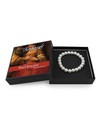Pearl bracelet 'The Jewish bride'
- Product description
- Reviews
Isaac and Rebekka , also Portrait of a Couple as Isaac and Rebekka and known as The Jewish Bride or The Jewish Bride , is a painting by the Dutch painter Rembrandt van Rijn in the Rijksmuseum in Amsterdam. The canvas is owned by the municipality of Amsterdam and has been on loan to the Rijksmuseum since 1885. According to the Rijksmuseum, it dates from circa 1665- circa 1669, the late period of the painter. It is a tranquil depiction of a man and woman in an intimate embrace against a diffuse background from which every detail is excluded. The work is considered one of Rembrandt's masterpieces. Vincent van Gogh was so impressed by The Jewish Bride when he saw it with a friend in 1885 that he said: 'Do you believe now, and I sincerely mean that, that I wanted to give ten years of my life, if I could sit here for a fortnight before this painting with a crust of dry bread for food. In October that year, Van Gogh wrote to his brother Theo: 'What an intimate, what an infinitely sympathetic painting'.







